
Fra Bartolomeo or Bartolommeo, also known as Bartolommeo di Pagholo, Bartolommeo di S. Marco, and his original nickname Baccio della Porta, was an Italian Renaissance painter of religious subjects. He spent all his career in Florence until his mid-forties, when he travelled to work in various cities, as far south as Rome. He trained with Cosimo Rosselli and in the 1490s fell under the influence of Savonarola, which led him to become a Dominican friar in 1500, renouncing painting for several years. Typically his paintings are of static groups of figures in subjects such as the Virgin and Child with Saints.
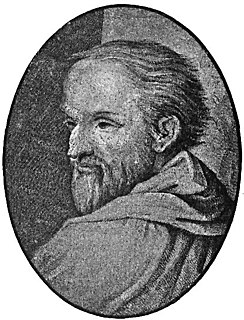
Antonio Allegri da Correggio, usually known as just Correggio, was the foremost painter of the Parma school of the High Italian Renaissance, who was responsible for some of the most vigorous and sensuous works of the sixteenth century. In his use of dynamic composition, illusionistic perspective and dramatic foreshortening, Correggio prefigured the Baroque art of the seventeenth century and the Rococo art of the eighteenth century. He is considered a master of chiaroscuro.

Pinturicchio, or Pintoricchio, also known as Benetto di Biagio or Sordicchio, was an Italian painter during the Renaissance. He acquired his nickname because of his small stature and he used it to sign some of his artworks that were created during the fifteenth and sixteenth centuries.
Bernardo Castello (1557–1629) was an Italian painter of the late-Mannerist style, active mainly in Genoa and Liguria. He is mainly known as a portrait and historical painter.

San Francesco a Ripa is a church in Rome, Italy. It is dedicated to Francis of Assisi who once stayed at the adjacent convent. The term Ripa refers to the nearby riverbank of the Tiber.

Giovanni Girolamo Savoldo, also called Girolamo da Brescia, was an Italian High Renaissance painter active mostly in Venice, although he also worked in other cities in northern Italy. He is noted for his subtle use of color and chiaroscuro, and for the sober realism of his works, which are mostly religious subjects, with a few portraits. His portraits are given interest by their accessories or settings; "some even look like extracts from larger narratives".

The Cerasi Chapel or Chapel of the Assumption is one of the side chapels in the left transept of the Basilica of Santa Maria del Popolo in Rome. It contains significant paintings by Michelangelo Merisi da Caravaggio and Annibale Carracci, two of the most important masters of Italian Baroque art, dating from 1600–1601.

San Silvestro al Quirinale is a historic church in central Rome, Italy. It is located near Via XXIV Maggio corner with Via Mazzarino, a few blocks south of the Piazza del Quirinale.
The decade of the 1440s in art involved some significant events.
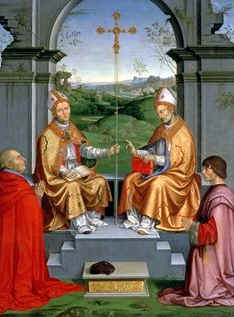
Timoteo Viti, sometimes called Timoteo della Viti or Timoteo da Urbino, was an Italian Renaissance painter, who was closely associated with Raphael, who was fourteen years his junior.

Christ taking leave of his Mother is a subject in Christian art, most commonly found in Northern art of the 15th and 16th centuries. Christ says farewell to his mother Mary, often blessing her, before leaving for his final journey to Jerusalem, which he knows will lead to his Passion and death; indeed this scene marks the beginning of his Passion. In early versions just these two figures are usually shown, at half-length or less.
Vincenzo Pagani was an Italian painter of the Renaissance period.

San Giovanni Evangelista is a church in Parma, northern Italy, part of a complex also including a Benedictine convent and grocery.

San Paolo is a former convent in central Parma, Emilia-Romagna, northern Italy. It is best known for housing the Camera di San Paolo, decorated by a masterpiece of fresco work (1519) by Correggio.
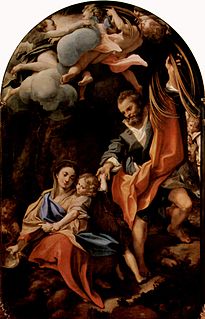
Madonna della Scodella is an oil painting on panel by Antonio da Correggio, dated from 1528 to about 1530 and preserved at the Galleria nazionale di Parma.
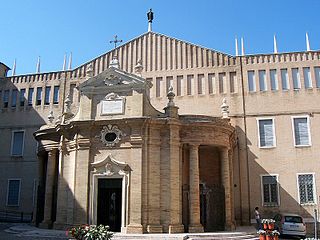
Santa Maria della Misericordia is a Renaissance-style, Roman Catholic basilica church and Marian shrine located on Piazza San Vincenzo Maria Strambi, next to the Cathedral, in the center of Macerata, region of Marche, Italy.

Santa Maria della Misericordia is a Roman Catholic church located on Via Santa Maria near Piazza Garibaldi in the historic center of the town of Correggio, province of Reggio Emilia, region of Emilia-Romagna, Italy. The church is presently deconsecrated and closed.

Christ in Glory with Saints and Odoardo Farnese or 'Christ in Glory with Odoardo Farnese and Saints Peter, John the Evangelist, Mary Magdalene, Hermenegild and Edward is a painting by Annibale Carracci. Placed in the Eremo di Camldoli either early in its life or straight after its creation, at the end of the 17th century Ferdinando II de' Medici moved it to the Galleria Palatina in Florence, where it still hangs.

Pietà with Saints Clare, Francis and Mary Magdalene is a 1585 oil on canvas painting by Annibale Carracci, now in the Galleria nazionale di Parma.
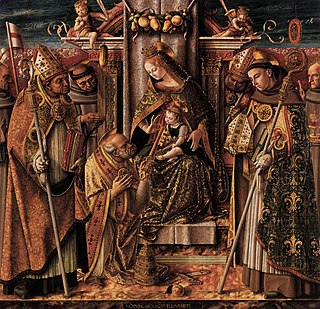
The San Pietro di Muralto Altarpiece or San Pietro degli Osservanti Altarpiece is a 1488-1489 tempera and gold on panel altarpiece by Carlo Crivelli and his studio, named after the Dominican church in Camerino in which it originally hung, and now divided between a number of American and European museums.

















